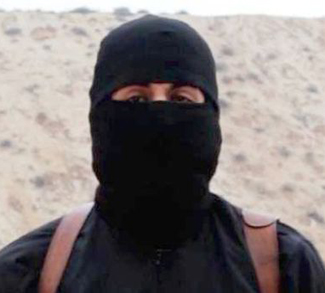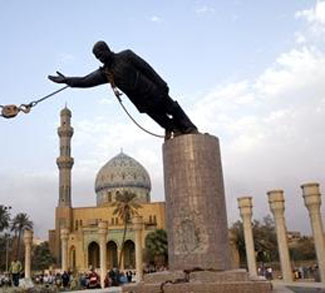His jihadist career has taken on nearly mythical dimensions. According to some reports, he is the mastermind behind Islamic State media operations. According to another, he was recently the target of a “honey-trap” set by a female FBI agent sent to Syria in order to extract information from him. On February 9, the US State Department designated German citizen Dennis Cuspert as a Specially Designated Global Terrorist. Formerly known as “Deso Dogg,” during his days as one of Germany’s most well-known gangster rappers, Cuspert more recently adopted the nom de guerre Abu Talha al-Almani (the German). The State Department designation comes after Germany itself submitted Cuspert’s name to be included on the UN Security Council’s list of designated terrorists and terrorist entities.
There is no doubt that since arriving in Syria in summer 2013, Cuspert had become a very significant recruiter of foreign and, above all, German-speaking jihadists. There is, however, significant doubt whether Cuspert is today even still alive. His death was announced on Arabic-language jihadist websites and Twitter feeds last April. According to the initial reports, he was killed on April 20 in a suicide attack on an ISIS safe house carried out by the rival jihadist group Jabhat al-Nusra.
Since that time, there appears to have been no verifiable sign of life from Cuspert. While numerous “new” pictures and videos of Cuspert have continued to emerge on the internet, none of this material is dateable. At least some of it has clearly been misconstrued in Western media reports and hence misdated. Moreover, since his reported death in April – and contrary to the impression given by the State Department announcement – Cuspert’s own activity as propagandist/recruiter has stopped cold.
This activity essentially involved two components: firstly, his appearance as featured “performer” in a series of highly-produced, professional quality videos celebrating jihad in Syria and encouraging German Muslims to join the fight; and, secondly, social media engagement via his own Twitter feed. Cuspert’s tweeting had been extremely prolific in the period immediately preceding his reported death. Thus, for example, on April 7 alone, Cuspert posted nearly sixty tweets.
Cuspert posted a last tweet on the morning of his reported death and then his Twitter feed went silent. (The tweet in question is no longer in his timeline, but it has been archived elsewhere.) The silence was momentarily broken on April 23 by a tweet announcing, “as salamu alaikum dear brothers and sisters i did not become shaheed [a martyr], it was a mistake, may allah accept the other bro.” This denial, like similar denials posted in other social media, was widely and enthusiastically disseminated by Cuspert fans and followers. Cuspert’s Twitter activity did not, however, resume. A cryptic tweet two weeks later, on May 7, announced, “Insallah soon back online with News around the State from the State of Honor [i.e. the Islamic State].with Love your Brother Abu Talha.” The promise was not kept.
Virtually all the very limited activity on the Twitter feed since then consists just of re-tweets and uncommented links to videos. The handful of “original” tweets are, like the April 23 and May 7 items, all in English. Cuspert had begun to experiment with tweeting in English, a language that he clearly did not master, before his reported death. But the great bulk of his Twitter activity was in his native German. This included extended conversations with a wide variety of interlocutors, including well-known German journalists Alfred Hackensberger and Florian Flade. There have been no such conversations since.
Following his reported death, Cuspert’s video activity likewise came to a halt. Some of his last tweets served to publicize the latest and in fact last videos in which he would star: For Allah and His Messenger, which shows Cuspert leading a chorus of masked mujahideen in a six-minute long nasheed or chant, and My Oath to the Islamic State. An over hour-long production, My Oath to the Islamic State contains both the famous oath in question and somewhat meandering reflections by Cuspert on why he decided to give it. Seated under a tree in a bucolic setting, Cuspert is filmed from several camera angles and 3D computer-generated captions are blended into the image from time-to-time to highlight particularly important points.
It should be noted that prior to his pledge of fealty, none of Cuspert’s videos were devoted to proselytizing specifically on behalf of the Islamic State. Indeed, in Raqma #3: And Allah is the Sustainer, a video released just months before his oath to ISIS, Cuspert can be seen cooperating with Jabhat al-Nusra and pleading for unity among the rival jihadist factions in Syria.
All of the supposedly “new” Cuspert videos that have emerged since his reported death are in fact just short amateur videos, which appear to have been shot with cell phones or cheap camcorders. Cuspert is present in these clips, along with other German- or Arabic-speaking jihadists, but he is not the focus. The clips have been posted on the web – in one case by an anti-ISIS organization – but, unlike Cuspert’s own videos, they have not been released under the logo of known jihadist media.
Some of this material appears to implicate Cuspert in atrocities. In one clip, for instance, he can be seen picking up a severed head. It must be said that he does not do so with the enthusiasm that one would expect of a seasoned jihadist and he quickly puts the head back down again. The clip was released in November by Deir ez-Zor is Being Slaughtered Silently, a group dedicated to documenting ISIS atrocities.
Efforts have been made to connect these clips with events that postdate his reported death: in particular, ISIS’s bloody conquest of the Shaer gas field near Homs in July and the massacre of hundreds of members of the Shaitat tribe in the region of Deir ez-Zor in August. But it is not in fact clear when exactly and under what circumstances the clips were filmed.
Just how hazardous such exercises can be, moreover, is demonstrated by another supposed pictorial sign of life of Cuspert: a famous photo reportedly showing him at Mosul dam in Iraq. ISIS briefly seized control of the dam in July. An alert Twitter user, however, identified the location rather as Tabqa dam in Syria. Comparison of the photo to satellite imagery of Tabqa dam (see below) makes clear that the photo is indeed taken at Tabqa. Note the cluster of small islands in the background of the Cuspert photo and the same small islands in the satellite image. The three steel towers in the background of the Cuspert photo are likewise visible in the satellite imagery. Tabqa dam is located roughly twenty miles from the ISIS stronghold Raqqa.
The Deir ez-Zor is Being Slaughtered Silently clip provides perhaps the most compelling evidence that Cuspert may indeed still be alive. The victims are identified as members of the Shaitat tribe, and Cuspert can be seen standing next to an Arabic-speaking jihadist who also figures prominently in some of the horrifying images that have emerged of the August massacres. It should be noted, however, that the man is dressed differently and the setting does not appear to be the same.
The Shaitat tribe is native to the region of Deir ez-Zor. As it happens, Cuspert was reportedly killed near Deir ez-Zor, at a time, namely, when ISIS was fighting to take control of the region. Does the clip document an earlier atrocity?
In any case, if Cuspert is still alive, why is he staying silent? In My Oath, he encouraged interested viewers to communicate with him on social media. There has been no such communication.
Cuspert’s silence, moreover, contrasts sharply with his vigorous reaction to an earlier report of his demise. In November 2013, Cuspert was reported killed in an airstrike by the Syrian air force that had taken place two months earlier. Video that emerged at the time showed his apparently lifeless body covered in blood in the aftermath of the attack. In early December, however, a clearly still convalescing Cuspert would re-emerge, displaying his scars and holding forth in an over hour-long interview on his injuries, the obligation of jihad, and the prospects that he would still become a shaheed or martyr. Cuspert noted matter-of-factly that he did not expect to survive the Syrian war.
As Cuspert got back on his feet, his propaganda activity, if anything, became even more intense, with several new videos being released and his Twitter feed being rolled out in January. Until, that is, April 20 and the Jabhat al-Nusra suicide attack against ISIS.
John Rosenthal is a guest contributor to Geopoliticalmonitor.com, and author of The Jihadist Plot: The Untold Story of Al-Qaeda and the Libyan Rebellion.





